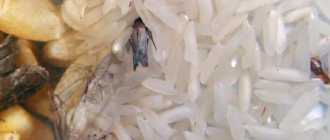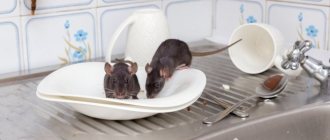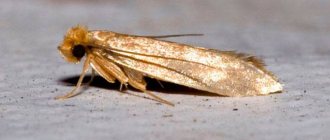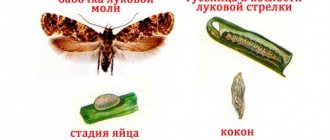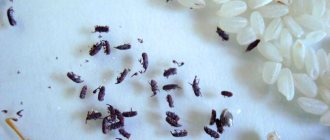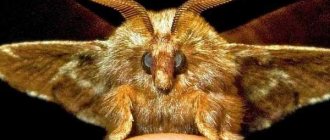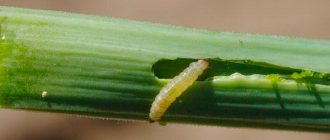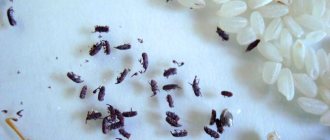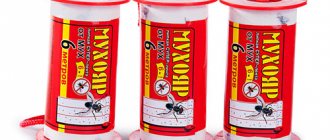16.11.2015
Food moths are popularly called moth moths, which lay their larvae in cereals or other food products stored in unsuitable conditions. Depending on which product the pest butterfly larva prefers, several varieties of these insects are distinguished. Even in appearance, food moths differ significantly from each other. However, people who are faced with their appearance are more concerned about the question of how to quickly get rid of the pest, rather than information about the varieties. And therefore, the purpose of this article is to give a complete answer to the question of how to deal with food moths.
- Introduction to food moths
- Signs of presence
- Where and why does it appear?
- What harm does she do?
- How to get rid of it
- Professional products
- Folk remedies
- How to prevent it from happening again
Signs of presence
In order to effectively combat insects that harm your products, you need not only to know what food moths look like, but also to understand how they get into the house where they live, and what harm they can cause to household members. In addition, it is advisable to familiarize yourself with the signs indicating the presence of this pest. The groceries (cereal products) are not eaten by the moth itself, but by its larvae (caterpillars). They don't disdain absolutely anything. If there is flour, cereals, cocoa, sugar, dried fruits, nuts, whole grains, crackers, bread nearby, an adult food moth may well lay eggs on them.
Especially many larvae are found in warehouses storing grain harvests.
Food moth in grain
With its activity there, the moth causes serious damage to agricultural crops. In general, the type of moth determines its food preferences, but in most cases the range of products affected by it is quite wide and varied. Regardless of what this or that species of grocery pest butterfly eats, in apartment conditions the insect eats any grocery product. Based on this information, we can conclude that moths parasitizing dry food can appear in the kitchen of any house or apartment.
Food moth web
Determining the presence of moth larvae in cereals, dried fruits, flour and other products is not difficult. This insect not only undermines household supplies, but also creates a thin web from which it forms a silk cocoon.
When butterfly larvae parasitize, lumps appear in flour or cereals, and inside the nuts - nests in which a worm (caterpillar) lives.
Food moth larvae in nuts
Description of the insect
The butterfly of the cereal (kitchen, grocery) moth has a gray-yellow or gray-brown color with a dark spotted pattern. The maximum length of the body is 1 centimeter, the wingspan is 1-1.6 centimeters. The insect flies slowly and chaotically, so it is easy to swat it with your hands.
The butterfly's mouthparts are not developed and it does not feed. Life expectancy is 5-7 days. In such a short period of time, the butterfly manages to lay 100-160 eggs. For successful reproduction, pests need warm temperatures (23-27 degrees), humidity of 50% and access to bulk products.
Fresh kitchen moth eggs are 0.5 millimeters long and white in color; later they turn yellow. After 1-2 weeks, larvae appear - the main culprits in the spoilage of cereals.
The body length of caterpillars varies between 0.3-1.5 centimeters. These are thin white worms with an orange dot on their head.
Kitchen moth larvae live and feed for 1-2 months, and then look for shelter (a crack in a cabinet, the bottom of a jar) to weave a cocoon and turn into a butterfly. The pupation process takes 2 weeks.
Where and why does it appear?
It is believed that a butterfly that spoils food cannot settle in a house just like that. Moreover, an insect of this species practically does not move by flying. It must be said that even a housewife who keeps her house perfectly clean is not immune from pest butterflies entering the kitchen. How do moths appear in cereals? It must be said that this insect has a tendency to travel, despite the fact that it flies poorly. If your upstairs neighbors are faced with such a disaster, then it is possible that the pest will be able to get into your apartment through the ventilation ducts. In rare cases, a butterfly enters a home through an open window or door. But the most common way moths get into the kitchen is the food itself, brought from the market (store) and already infected with the pest. Such situations happen especially often if the housewife purchases cereals, flour and other groceries already packaged (in non-sealed bags) and does not have the opportunity to check the condition of the products.
Cereals and dried fruits in bags
Food moths often parasitize industrial grain storage facilities. The parasite larvae are transported in bags of cereal products from one food warehouse to another, infecting more and more bags of grain.
Insects in cereals reproduce quite quickly, and even if one adult gets inside a grocery bag, getting rid of the parasites will be extremely difficult, if not impossible. Preventing moths from multiplying in grains and dry foods cannot be done either by lowering (or increasing) the humidity level or by placing grains and flour in sealed glass containers. Even blocking the air flow and the complete absence of ventilation cannot prevent butterflies from laying eggs, or caterpillars from absorbing dry food. An ordinary food moth is capable of laying eggs even in those cereals that are located next to the contaminated product, in unsealed packaging. And therefore, if you notice at least one flying moth in your kitchen, then it’s time to think about where it came from and how to get rid of moths in cereals as quickly as possible.
Peculiarities
The grain moth is an inconspicuous small butterfly (up to 10 mm) of gray or black color.
On the wings of gray insects you can see black inclusions in the form of a pattern. The pest belongs to the same family as clothes, flour or fruit moths. A distinctive feature of the cereal moth is its feeding on dry bulk products: rice or buckwheat, flour, grain. The insect can even live in nuts and dried fruits. Adults do not use them for food, but only lay eggs there. It is the hatched larvae that pose a threat to groceries. The lifespan of the cereal moth is 5-6 days, some individuals live up to 3 weeks. The insect reproduces very quickly, managing to leave behind enough offspring. The pest hides in secluded, hard-to-reach places. The grain moth is active at night, so it cannot be detected immediately.
Cereal moth
What harm does she do?
Faced with the problem of food spoilage by food moths, every housewife should find out why this butterfly is dangerous. The main harm from it, of course, is associated with food spoilage. Groceries contaminated with moth larvae become completely unsuitable for consumption. Products infested with moths in a warehouse are no longer suitable for sale. If cereals in industrial premises are damaged by food butterflies, this is fraught with a strong decrease in the quality of the product and serious material costs for suppliers.
The risk of bringing moth larvae into your home increases if you buy cereals at reduced prices on the market. It is precisely such food products that are often contaminated with the egg-laying of the pest butterfly.
Fur
Interestingly, the food butterfly is completely harmless to fur products and clothing. However, such information does not mean at all that if there are food moths in the house, there is no need to take preventive measures to prevent the appearance of clothes moths. It must be said that both of these insects feel good when close to each other. At the same time, a moth that eats food will be noticed much earlier than one that lays its larvae in dresses and woolen items.
Moth in the wardrobe
If you find traces of moths on clothes, you will need to check all the closets in which items made from natural fabrics are stored.
Also pay attention to carpets, curtains and shoes. Bedding and bedding that lie idle for a long time can also be a habitat for moths. The most attractive to her are cotton mattresses and blankets, woolen blankets and feather pillows.
The most attractive to her are cotton mattresses and blankets, woolen blankets and feather pillows.
In a well-ventilated area, moths are unlikely to grow. Also, insects are not interested in clothes that are worn regularly. She loves secluded dark corners, such as closets full of things, and is attracted to dampness and dirty clothes. If there is even a small damp spot on the fabric, it is this area that the moth will begin to eat first. The smell of sweat from things and fresh damp spots can become a source of food and a place where the insect will lay eggs.
Prevention
Empty the closet completely. Clothes must first be taken out into the fresh air - onto the street or an open balcony. On a sunny day, adult moths will leave their habitat much faster. You can simply shake off the larvae - they stick weakly, so there will be no problems.
After washing, pack out-of-season clothing in plastic covers or bags.
How to get rid of it
Control of food moths should be carried out at all stages of insect development (from larvae to adults). The statement that to get rid of this butterfly you need to fight only its larvae, and the adult insect does not cause any harm to groceries, is fundamentally incorrect. The thing is that a butterfly flying from place to place can form an oviposition with about 160 eggs in each bag of cereals. Within a week, new larvae will hatch from them, which, naturally, will erode food products. And for this reason, protection against food moths must be comprehensive. In this case, the following measures are envisaged:
- At the initial stage, you should find places where moth larvae accumulate. For this purpose, all food products (especially flour and cereals) are sorted. Old food supplies are carefully checked for the presence of larvae and oviposition of the pest butterfly. If products infected with the pest are suddenly discovered, they are either completely thrown out, or (if there are too many infected products and their complete destruction will lead to serious losses) they are thoroughly heated in the oven for half an hour, setting the heating temperature to at least 60 ºC. Using this recommendation, you can remove most of the harmful insects from your home.
- It is possible to destroy ovipositions, larvae and adult moths that have settled in cabinets next to bulk food products by treating the internal surfaces of the cabinet with aerosols based on insecticidal components. Drugs in this category include Antimol, Armol, Raptor, known to many consumers, against food moths. You should not be too careful in choosing drugs to kill pest butterflies. The fact is that their destruction with aerosols is only an auxiliary and, most often, preventive operation, which, unfortunately, does not give 100% results. After all, food products cannot be directly treated with an aerosol product, and therefore the moth’s egg-laying eggs in them remain unharmed.
- It is much easier to destroy adult moths than larvae and eggs. For this purpose, experts recommend using regular sticky fly strips, which are sold in many hardware stores. You can also use the old-fashioned method - a rolled-up newspaper or a fly swatter. Due to the fact that food moths fly very poorly, it will be easy and simple to destroy them. A trap for food moths, for example Aeroxon, also demonstrates an excellent effect.
Trap for food moths
It has a specific aroma that attracts insect pests. The adhesive surface firmly holds unwary butterflies. The cost of such a trap is approximately 200 rubles, and you can purchase it in specialized stores or online.
At the moment, there are no simpler measures aimed at combating food moths. If this insect is found in a large production enterprise, then special fumigators containing phosphine are used to destroy it. Grain infected with moth larvae is sprayed with contact-acting insecticidal preparations. However, it is worth considering that such processing of food products cannot be done indoors - spoiled food is taken outside before disinfection.
What does the parasite eat?
The answer to this question is simple; it all depends on the type of pest. It is worth knowing that an adult eats practically nothing. Only larvae laid by an adult can actively feed. If the food source is suitable for them and there is a sufficient amount of it, the larvae gain weight and size very quickly. When the larva has already fattened well, it begins to pupate and spends about 2 months in a cocoon state. After this, an insect appears that resembles an ordinary gray moth.
Domesticated moths thrive in a comfortable environment. For example, a dress type takes up residence in a closet or chest of drawers. Valuable protein necessary for its full development is contained in woolen products. It is easily absorbed in her body, giving the cells the necessary energy. In addition to woolen products, moths can feed on clothing containing wool and synthetics. If the insect eats natural fibers intertwined with synthetic ones, then its development will slow down.
This one also loves to eat natural fur coats, sheepskin coats, and carpets. Most often, they choose not very fresh things, because they prefer those that have been worn for a long time. Clothes moths also eat cotton clothing and silk upholstery in furniture. Sometimes she can switch to food and eat cereals, dry bread, and cereals.
Food moths, unlike clothes moths, cannot feed on clothes in the closet. She only eats food. It cannot cope with fabric or fur fibers, since the digestive juices of this type of insect do not contain the necessary enzymes. Food moths eat almost the same foods as humans.
Professional products
Every good housewife should understand that proper storage of cereals in the kitchen is the most powerful preventive measure against the appearance of food moths. If such a pest does appear in the house, then it is impossible to completely get rid of it without disinfestation and disinfection of all cabinets, bedside tables and other surfaces in which the moth lived. Control measures are selected in accordance with the type of moth that has settled in the home. It must be said that getting rid of grain butterflies is often much easier than getting rid of barn butterflies.
Not every housewife knows how to destroy food moths in an apartment. It is completely possible to completely remove such a pest from your kitchen only if you use powerful chemicals and insecticides in combination. Food moth control products based on chemicals can be divided into two large groups:
- Elimination insecticides that contain certain toxic components that can destroy adult butterflies and moth larvae.
- Repellents. These preparations are created primarily on the basis of plant components and their main goal is to repel insect pests.
The most common chemical remedy for food moths today is called an aerosol. It is presented in the widest variety on the market, and therefore any consumer interested in how to get rid of food moth larvae and butterflies themselves will be able to choose the optimal and effective drug. The main advantage of anti-moth aerosols lies in the fact that they make it possible to carry out quick disinfestation. The most common aerosol poisons against moths are:
- Antimol – recommended for treating kitchen furniture and fabrics. The drug reliably protects the house from moths of any kind for one year after treatment;
- Raptor is a highly effective remedy that allows you to get rid of not only moths, but also their larvae. It should be sprayed onto furniture surfaces, and the drug retains its effectiveness for 1 year, provided that the furniture is not washed;
- Combat is a universal drug that helps cope with all types of moths. Its advantage lies not only in creating protection against moths, but also in absolute safety for pets. Combat is sprayed onto the surface and joints of furniture, as well as in the corners of the kitchen.
Moths in the kitchen and its varieties
Even the tidiest and absolutely clean kitchen can harbor moths. Very often it gets there with purchased food, especially cereals or flour. But, if “invaders” do appear in the kitchen, they must be removed from there. Some tips on how to fight larvae and butterflies in the kitchen:
- using a soapy solution, thoroughly wash the cabinets and shelves using a vinegar solution;
- prepare the solution according to the scheme: 2 tsp. Pour tea tree oil and a teaspoon of alcohol into two cups of water, and disinfect all cabinets with the resulting solution;
- Wrap the wormwood in gauze and place it in the places where the moths are located.
Folk remedies
For some housewives, it is extremely important to know how to get rid of food moths without spoiling the food? Everything is simple here. If you are afraid to use chemicals against food pests, then be sure to pay attention to folk remedies for food moths.
Ingredients for folk remedies
There are a lot of them and they are in no way inferior in effectiveness to more dangerous chemicals. So, in the fight against moths they will help you:
- Lavender bags. Make small cloth bags with drawstring ties and fill them to the top with fresh or dried lavender. Place this craft in a closet where food moths have infested. The butterfly does not tolerate the smell of the essential plant and will try to find a safer habitat for itself by leaving your home. By the way, lavender essential oil is now sold in pharmacies, which can also be used to fight moths and their larvae. Just soak a cotton swab in ether, roll it into a ball and place the structure in places where parasites accumulate.
- Garlic-based seasonings. If you peel garlic cloves and cut them into slices, and then place them on a plate and place them in a kitchen cabinet in which moths have infested, the pest will quickly leave its habitat, unable to bear the pungent odor. The advantage of garlic is that it can be placed directly into flour affected by moth larvae. The garlic smell will not be transferred to the grocery store, but it will help drive away moths.
- Orange peels. The sharp aroma of citrus will repel food moths from cabinets and containers with bulk products in the kitchen. However, it should be remembered that old zest does not emit a strong aroma, and therefore the crusts must be changed periodically.
- Mint. Surprisingly, the aroma of mint, pleasant to people, becomes a deterrent to food moths. In the summer, you can hang mint tied in bunches in the kitchen to dry - this will help prevent the appearance of harmful insects that spoil food.
- Rosemary - this plant also has a very unpleasant and pungent odor that repels pest butterflies. If you don’t want food moths to appear in your kitchen, just start growing a spice called rosemary there. The plant does not require special care and feels great in ordinary flower pots. Rosemary belongs to the category of perennials, and therefore it can be planted once and then simply cared for for many years. The fragrant leaves will be an excellent seasoning for your dishes, and in addition to eating, rosemary can be placed next to dry food. Scented geranium has a similar effect. Also place a pot of it in the kitchen if you are afraid of an invasion of food moths.
- Forest herbs. Collections of tansy, wild rosemary, and wormwood, thoroughly dried and folded into bags, will help remove not only moths, but also bedbugs and flies from the kitchen. Small bouquets are made from these herbs and placed in kitchen cabinets. However, do not forget that wild rosemary is a poisonous plant, and therefore should not be placed near food. And the aroma of wild rosemary has a bad effect on the human body, causing severe headaches.
- Bay leaf is a plant that also belongs to the esters and has a pungent odor. Of course, fresh laurel branches will give the best effect in the fight against food moths, but if there are none, you can replace them with dried bay leaves, sold in every grocery store.
- Camphor. The pungent smell of essential camphor oil or even camphor alcohol (which is sold in pharmacies) will drive food moths out of your kitchen for a long time. The internal surfaces of the cabinets in which the contaminated products were stored are wiped with camphor alcohol. For this purpose, the drug is first diluted with water in a 1:1 ratio. You can also soak cotton pads in camphor and place them in cabinets. As the aroma of the ether wears off, the cotton pads should be changed.
- Walnuts. Another effective remedy against food moths is the walnut, or rather its leaves. They should be placed throughout the kitchen, as well as in cabinets where cereals are stored. The insect cannot stand the smell of fresh nut leaves and flies away. But for effective control, do not forget to periodically replace wilted nut leaves with new, freshly picked ones.
- A mixture of vinegar and laundry soap. In the fight against food moths, a good remedy is laundry soap dissolved in water with the addition of vinegar essence. This composition should be used to wipe all kitchen surfaces daily. This method of eliminating moths is classic, but at the same time very effective.
- Perfume components. Food moths do not tolerate the smell of perfumes, especially floral or cheap ones.
Bugs in the apartment - photos and names
Woodworm
- The bug is no more than 3 mm in size and is brown, sometimes black.
- The danger comes from the larvae of this beetle, which can live in wood for many years.
- These pests literally turn the tree into “wood dust.”
Book louse
- A very small bug. Its body length is only 1 mm.
- Color - various shades of brown.
- In an apartment, the pest lives on bookshelves, as it feeds on the glue under the bindings of books.
- It is very dangerous for home libraries, as it can significantly spoil the appearance of books and albums.
Carpet beetle
- A small brown bug. The length of its body is no more than 5 mm.
- He feels good in apartments, as he eats foods available in the kitchen and various cereals.
- In addition, it can cause more serious damage, damaging furniture, carpets, as well as wool, silk and leather products.
- Finally, the bug is dangerous to humans because it bites, and therefore can infect a person with infectious diseases or provoke allergies.
Bark beetle
- The bug is extremely dangerous.
- Body length reaches 1.5 cm.
- It lives under the bark, feeding on wood. Pest larvae feed on tree sap.
- This pest and its larvae can quickly destroy everything in an apartment that is made of wood.
- It is very difficult to get rid of this type of bugs.
Flour beetle
- The bug is brown in color.
- The length of its body is from 5 mm to 2 cm (small and large Khrushchak, respectively).
- A small mealworm lives in a person’s apartment. He lives in the kitchen.
- It multiplies very quickly.
- In a short time it can spoil flour, various cereals, pasta and dried fruits.
- The larvae of this pest are called mealworms.
springtail
- A small white bug. Body length up to 1 cm.
- Lives in flower pots.
- It feeds on the roots and leaves of plants.
- It easily spreads from one plant to another, as a result of which the latter begin to wither and die.
- Springtails love moist soil, so you should avoid over-watering indoor plants in your apartment.
Grinder
- A relatively small bug. Its body length ranges from 1 mm to 1 cm; It even looks cute.
- Color – dark brown, black.
- Sensing danger, the pest immediately pretends to be dead.
- The beetle makes sounds by which you can understand that the pest has entered the apartment and has begun its destructive activities. These sounds are similar to the ticking of a clock.
- The larvae of these insects are very dangerous. They eat up to 99% of the wood.
- The apartment is usually inhabited by furniture, comb-whiskers and bread grinders.
- The furniture grinder literally eats furniture, making holes in the wood with a diameter of up to 3 mm.
- The comb grinder, as the name suggests, has long mustaches. The pest stays deep in the wood until it is completely destroyed.
- But the bread grinder prefers to wood the more delicious food that he finds in a person’s kitchen. These are, naturally, various cereals, pasta, dried fruits, etc.
Silverfish
- The bug is small.
- It has a beautiful silver color.
- It loves warmth and moisture, so in an apartment it can be found in the toilet, in the bathroom, at the kitchen sink.
- It feeds on sugar, starch, as well as any products containing these components.
- The bug is not dangerous for humans, since it does not bite and, therefore, is not a carrier of infections.
Shashel
- The bug is very small. Its body length is only 3 mm.
- Can fly.
- The color is most often black.
- This pest lives in wooden furniture and wooden walls.
- The larvae of this insect make passages inside the tree, from which dust then falls. And if such rot is noticed, it is necessary to urgently take measures to destroy the bugs.
How to prevent it from happening again
Timely preventive measures will help prevent the reappearance of moths and their larvae inside the home. It must be said that the destruction of food moths is only half the battle. An important aspect is to prevent further appearance of the butterfly in the kitchen. Preventing the appearance of harmful insects in a house or apartment involves taking the following steps:
- When purchasing groceries, check each product carefully;
- Do not buy groceries at reduced prices;
- You should not buy food for future use. Make purchases of cereals that you and your family can finish within one week;
- Use moth repellents (for example, lavender or mothballs) in your home. Just try not to let them come into contact with food.
Moths cannot tolerate the smell of lavender and other herbs with a strong aroma (tansy, wormwood, rosemary). Essential oils, strawberry-scented soap or regular laundry soap, orange peels, horse chestnut cones, and the smell of vinegar give a good effect against the appearance of food moths.
The main thing to remember when fighting moths and their larvae is an integrated approach. If, for example, you put lavender in a cabinet where contaminated cereals are stored in sealed containers, it will not be able to destroy the larvae. And the butterflies that subsequently emerged from them simply will not react to the pungent aroma.
If you managed to get rid of moths in the kitchen, then try to prevent them from appearing in the future. Check food supplies periodically, close windows with mosquito nets, and cover ventilation openings with special grilles. Regularly wipe kitchen cabinets with a vinegar solution, and store cereals and flour in airtight glass jars. And, of course, do not buy groceries in torn packages or at too low prices. Such safety measures will help prevent food moths from appearing in your home.
Prevention
Housewives are interested in how to store cereals and things in the house so that moths do not appear.
There are a number of rules for this:
- You should not buy a lot of cereals, nuts, tea at once. It is better to replenish supplies as needed.
- Cheap loose cereals may contain insect larvae, so you need to purchase cereals in hermetically sealed packs and bags.
- Periodically check existing supplies for the presence of the parasite and its larvae.
- It is worth storing provisions in glass or metal containers.
- You need to place bunches of aromatic herbs on the kitchen shelves and in the closet. They need to be changed as the smell dissipates.
- After purchasing the cereal, you should immediately bake it in the oven. Old stocks that are not visually infected are also kept there for about 15 minutes. In winter, grains can be frozen as an alternative.
- It is not recommended to create significant accumulations of garbage in the house in the form of old things, carpets, pillows.
Reasons for the appearance of bugs in cereals and flour
Bugs themselves do not appear out of nowhere, and they almost never enter a person’s home:
- The most common reason for their appearance is that you brought them yourself, with some of the products. Alas, despite all the norms and state standards for production and sales, it is quite simple to buy a product infested with insects.
- Bugs can end up in the cereal already at the production stage, say, at the factory where it was produced, supposedly neutralized from parasites, dried, threshed and packaged.
- They may get into the bag during transportation or in one of the storage warehouses.
- Often these midges live in stores and supermarkets, where they instantly master each new batch of goods.
- Or they settle in bakeries or bakeries and from there migrate to your kitchen in a loaf of bread or a bunch of dry goods.
- Bugs can also enter along with food from neighbors who shared a glass of flour, friends or relatives who sprinkled you with some nuts or dried fruits.
- Since these insects are quite tenacious and unpretentious, they can penetrate into the cracks and joints of furniture. Therefore, one of the ways to add such an inhabitant to yourself is to purchase used kitchen furniture or interior detail, from which they will very quickly crawl out and get comfortable in a new place, closer to your food.
